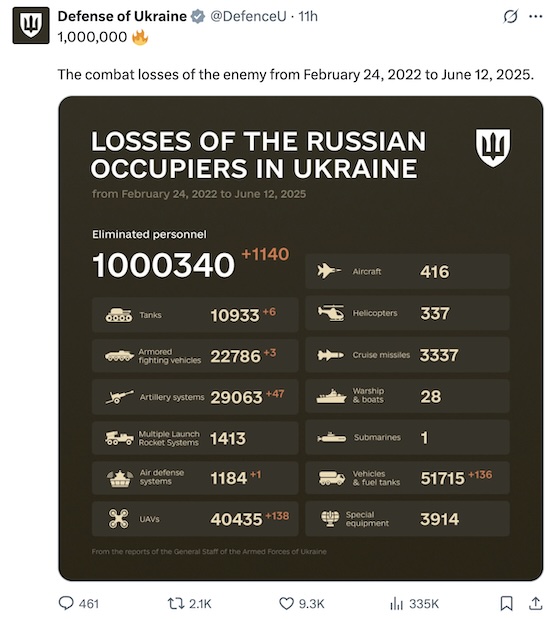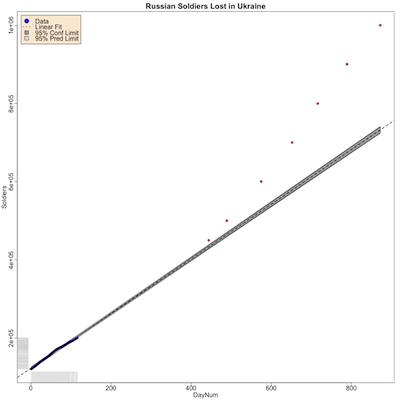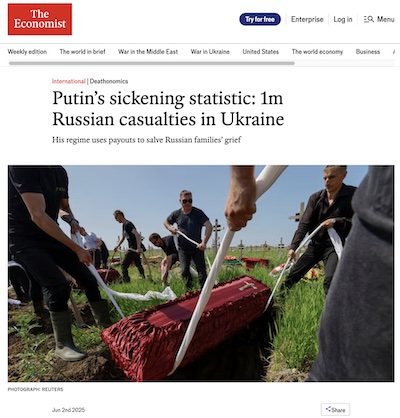Ukraine War: 1,000,000 Russian Dead?!
Tagged:MathInTheNews
/
Politics
/
Sadness
/
Statistics
Russian dead in Ukraine: 1,000,000. I hardly know what to say.
How We Got Here
Yes, we’ve been writing, here on this Crummy Little Blog That Nobody Reads (CLBTNR), about the outrage in Ukraine for quite a while now. [1] [2] [3] [4] [5] [6] [7] [8] [9] [10] [11] [12] [13] But the thing is… the outrage just keeps going on and on, beyond the bounds of sanity for even the most power-obsessed dictator.
We’ve been using the Ukrainian Ministry of Defence’s figures for Russian casualties. Of course, one could object that they are a biased source. But when we looked at other sources, they were kind of in the middle of the pack. Some sources were wildly inflated, while others had extremely hard to believe small numbers. (The latter were institutions that insisted on a very high standard of evidence, like geo-location, identities, photographs, and so on. This leads to a very severe under-count, so people usually take their estimates and apply a multiplier derived… somehow.) The Ukraine MoD says they count, every day. That might even be true. But they seem reasonably credible compared to others, and they are the ones on the spot. So we’ll take their figures.
Today, sadly, it appears that Russian casualties have reached the 1 million mark:
 They’ve blown a hole in the demographics of Russia: as we calculated before when the
casualties hit 700k, this is around 4% of the population of Russian males of military
age:
They’ve blown a hole in the demographics of Russia: as we calculated before when the
casualties hit 700k, this is around 4% of the population of Russian males of military
age:
…so 1 million dead is approximately 4.2% of that generation of Russian men. (See 700k post on mortality statistics for sources, mainly WorldOMeter for population & Wikipedia for demographic mortality curve.)
I’ve seen estimates that a comparable number (ca. 900,000) Russian men of military age have prudently left Russia to live in other countries. That would just about double the demographic hole to about 8% of Russian men ages 18-44 being dead or absent.
Again, a slight misquote of Bertrand Russell is in order:
“The mark of a civilized man is the capacity to read a column of numbers and weep.” – Bertrand Russell, who said things like this if not exactly this, but would in any case almost certainly agree with the sentiment
Comparison Against Our Casualty Rate Model
 Alas, our regression model of Russian casualties that we built on the first 116 days of the war.
remains sadly relevant:
Alas, our regression model of Russian casualties that we built on the first 116 days of the war.
remains sadly relevant:
- Shown here is the plot of casualties (vertical axis) versus time in days since start of the war (horizontal axis).
- In the lower left you see the first 116 days of casualties, up to 200,000 dead in blue points.
- The regression fit to those first 116 days is the dashed line, while the 95% confidence limits and prediction limits are shown in gray bands around it. (If you don’t quite grasp what those mean, the practical import is that the regression model is very good and provides relatively tight predictions.)
- In the upper right you see in red dots the more recent data (450k, 500k, 600k, 700k,
800k, 900k, and now 1,000,000 dead) plotted against the model trained on the data with
less than 200k dead.
- The practical import of that is we can compare casualty rates now versus those at the beginning of the war.
- The red dots are:
- Above the trend line,
- Statistically significantly above it (outside the gray bands).
- For a while there appeared to be some evidence that the red dots were supralinear, i.e., Russian deaths were increasing faster than linearly in time, or accelerating. This no longer looks to be the case, since we have enough of the red dots to see that they’re sort of linear. It just appears that, around day 400 of the war, the Ukrainians got really good at causing more Russian casualties. Or perhaps the Russians started resorting to human wave, meat grinder attacks. (In the 800k post, we showed some evidence pointing to improved Ukrainian tactics being at the root of the death rate increase.)
Conclusion: Russians are still dying faster than at the beginning of the war.
From The Economist: The Economics of Causing Deaths in Your Own Population
 A couple weeks ago, there was an informative article in
The Economist [14] anticipating today’s sad progress mark
of 1,000,000 Russian dead.
A couple weeks ago, there was an informative article in
The Economist [14] anticipating today’s sad progress mark
of 1,000,000 Russian dead.
First, it appears that the Russian population is unsurprisingly, but aggressively, propagandized by the Putin régime:
… convincing most Russians that they are engaged in a war against an imperialistic NATO and that there is glory in death, with increasingly lavish contracts for those willing to sign up.
That’s certainly consistent with the Moloch idea having taken firm root in the minds of Russian leadership.
The problem, of course, is how everybody else deals with a nation that does not value the lives of its citizens:
Yet Russia’s ability to shrug them off and to keep recruiting men to throw into meat-grinder attacks ought to also pose sobering questions for NATO’s European members: how can democracies that value the individual deter an adversary so unconcerned about the lives of its soldiers that it will sacrifice them, year after year, in a punishing war of attrition?
They’ve coined the term ‘deathonomics’ for Putin’s ideological militarization of Russia, basically printing money to buy human sacrifices:
By the end of last year, according to Elena Racheva, a Russian former journalist who is now a researcher at Oxford University, the signing on bonus had reached 1.19m roubles ($15,000), while the average annual pay for a contract soldier was between 3.5m and 5.2m roubles, or up to five times the average salary. If a contract soldier is killed, his family will receive between 11m and 19m roubles.
…
Mr Golts says that the impact can be seen in small towns across Russia where recruitment has been most brisk. New houses are being built, smarter cars are turning up on the streets, and nail bars and gyms are opening.
…
For the families of the dead and injured, huge payouts “alleviate… their grief, such as feelings of injustice … and allow society to avoid moral responsibility for the casualties and injuries they endure,” Ms Racheva wrote. In other words, the contract is not just between the soldier and the state. The question which nobody can answer is how long that contract will hold.
Some other disturbing facts from The Economist:
- Scale: Russian casualties are on same scale as US losses in WWII, since the US population then was similar to Russia’s today.
- Severely wounded: The ratio of severely wounded to killed is generally about 4:1, so we should expect there to be about 4,000,000 severely wounded Russians. (I have some doubts here, since there is evidence that the Russian military isn’t very good at combat search and rescue or medical evacuation. The Ukrainians have been taking prisoner a lot of abandoned wounded Russian soldiers.)
- Ukrainian casualties: We don’t have much on Ukrainian casualties, but in December last year Zelensky said they had 43,000 dead + 370,000 wounded Ukrainians total. That’s… startlingly low compared to Russia, and indicates a wounded:killed ratio of about 8.6:1, instead of 4:1. So… no idea what to make of that.
- Technology: Drones today are like machine guns were in WWI. Machine guns made infantry too expensive to use until new tactics and machinery were brought to bear in WWI, like tanks. What the counter to drones will be, nobody knows.
The Weekend Conclusion
Psychopaths like Putin and Trump are seeking power through modern-day versions of the worship of Huītzilōpōchtli. and Moloch.
You just can’t believe they’ll be that evil, so they can get away with it for such a long time. It’s past time for the rest of us scream “Stop!” at both of them, and pull their fangs with demonstrations, general strikes, slowdowns, document leaks, and all the rest of the methods of nonviolent resistance.
Such worship of Moloch is shameful. Just as Moloch required sacrificing your children by burning them a red-hot metal idol, so it is here.
(Ceterum censeo, Trump incarcerandam esse.)
Notes & References
1: Weekend Editor, “Another Grim Anniversary”, Some Weekend Reading blog, 2023-Mar-02. ↩
2: Weekend Editor, “Do the Ukrainian Reports of Russian Casualties Make Sense?”, Some Weekend Reading blog, 2023-Apr-15. ↩
3: Weekend Editor, “Update: Ukrainian Estimates of Russian Casualties”, Some Weekend Reading blog, 2023-May-01. ↩
4: Weekend Editor, “Updated Update: Ukrainian Estimates of Russian Casualties”, Some Weekend Reading blog, 2023-May-09. ↩
5: Weekend Editor, “Updated${}^3$: Ukrainian Estimates of Russian Casualties Hit 200k”, Some Weekend Reading blog, 2023-May-17. ↩
6: Weekend Editor, “Ukraine Invasion: 250k Russian Dead”, Some Weekend Reading blog, 2023-May-17. ↩
7: Weekend Editor, “Tacitus in Ukraine”, Some Weekend Reading blog, 2023-May-25. ↩
8: Weekend Editor, “Casualties in Ukraine: Grief Piles Higher & Deeper”, Some Weekend Reading blog, 2024-Apr-10. ↩
9: Weekend Editor, “Post-Memorial Day Thought: 500k Russian Dead in Ukraine “, Some Weekend Reading blog, 2024-May-31. ↩
10: Weekend Editor, “Ukraine: 600k Russian Dead”, Some Weekend Reading blog, 2024-Aug-27. ↩
11: Weekend Editor, “Ukraine War: 700k Russian Dead”, Some Weekend Reading blog, 2024-Nov-04. ↩
12: Weekend Editor, “Ukraine War: 800k Russian Dead”, Some Weekend Reading blog, 2025-Jan-08. ↩
13: Weekend Editor, “Ukraine War: 900k Russian Dead”, Some Weekend Reading blog, 2025-Mar-21. ↩
14: Economist Staff, “Putin’s sickening statistic: 1m Russian casualties in Ukraine”, The Economist, 2025-Jun-02. NB: Link goes to an unpaywalled archival page. ↩

Gestae Commentaria
Comments for this post are closed pending repair of the comment system, but the Email/Twitter/Mastodon icons at page-top always work.